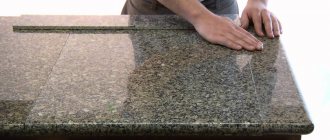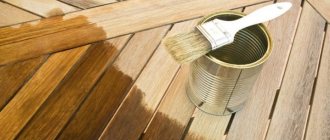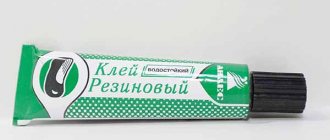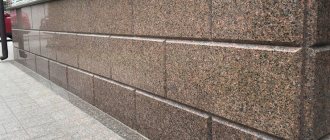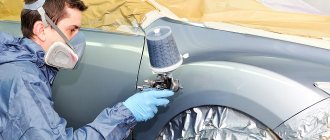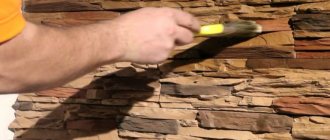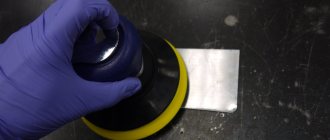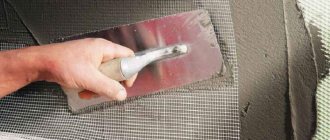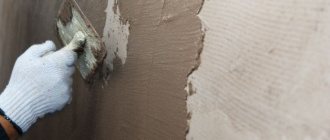How and with what to apply water repellent?
Hydrophobic impregnation is applied last, when all construction work is completed. This is done in several ways:
- With a brush. Product consumption is less, but work time increases.
- Spray. The cost is higher, the work goes faster. When sprayed, artificial stone and joints absorb more product and are therefore more protected.
Manufacturers recommend applying the water repellent while wearing protective glasses and gloves to prevent contact with skin and mucous membranes.
Operating principle and purpose
Primer mixtures began to be used relatively recently. For a long time, wallpaper glue, PVA or diluted dye were used as a base. Today there are many varieties of primers that perform different tasks. Thanks to the use of such tools, the following results can be obtained:
- protect the surface from the influence of negative factors;
- increase the adhesion of paint to the base;
- achieve insulating properties.
Soils differ in type and purpose. This affects the depth of their penetration into the base, its strengthening and the quality of adhesion after applying the surface to the material. The use of primers reduces dye costs. This helps achieve significant savings, makes the application of dye or glue more uniform, and protects the surface from mold and fungi.
Strengthening primers can be applied to different types of coatings. They help fill the porous structure of concrete surfaces, increasing their resistance to external factors. In addition, such substances increase the degree of adhesion with finishing materials.
Concrete has a high degree of density and low absorbency. Therefore, applying paint without preliminary preparation will not give results. Such compositions will be the right choice when using heavy wallpaper as interior decoration. Otherwise, no adhesive composition will be able to hold the sheets on the concrete surface.
Primer mixtures can also be applied to the following surfaces:
- plastered walls;
- plasterboard sheets;
- brick;
- gas blocks;
- foam concrete.
Thanks to their characteristics, such primers can safely be considered universal. Strengthening mixtures are ideal for application to surfaces in conditions of high humidity. They are often used for bathrooms and kitchens. In such places, the walls are constantly in contact with water and high humidity, which often provokes the formation of fungi and mold.
A primer containing antiseptic components helps protect surfaces from the development of pathogenic bacteria and fungi.
See also
Composition and characteristics of paints for ceramics, types and application rules
“Wet stone” effect as a decorative technique
Some water repellents can change the color of artificial stone due to the formation of a film. The color of the stone may become more saturated, like after rain. This effect has become very popular, so manufacturers began to produce special water repellents that create a “wet stone” effect. For example, Tiprom-M impregnation with the property of hydrophobization. This composition not only protects the stone, but also creates the effect of a wet surface. This impregnation can visually “update” the façade of a country house.
How to reduce water absorption of gypsum
Hydrophobization is a simple and sure way to improve the characteristics of stucco. For this product:
1. Treated with special substances.
2. Hydrophobizing additives are introduced into the gypsum dough at the production stage.
Water repellents protect gypsum corners, baseboards and columns not only from moisture. They prevent the formation of mold and mildew, and efflorescence.
Apply with a spray or brush to a previously cleaned surface and dry fairly quickly. Despite the reduction in water absorption, the strength of the finished products remains unchanged. Increases resistance to low temperatures.
What's the result?
- 1.Hydrofobizator creates a protective film and extends the service life of artificial stone and seams, protects against the formation of efflorescence, fungus and mold.
- 2. The best water repellent for artificial stone is a solution based on organosilicon. But if you want to work at subzero temperatures, then use a composition based on silanes and siloxanes
- 3. Impregnation should be applied in 2 layers with a spray gun - using the “wet on wet” method. Particular attention is paid to the lower part of the facade, because it gets wet the most.
- 4.If the solution gets on adjacent surfaces - windows, frames or doors, wipe them with a damp cloth.
The assortment of the Unimart cybermarket includes a wide selection of water-repellent impregnations for artificial stone “Tiprom” and “Perfecta”.
Do-it-yourself priming of walls before plastering: step-by-step technology for application and use
To get a good result, you need to properly prepare the walls and treat them with a primer. Before starting work, it is recommended to read the manufacturer's instructions, which are located on the product packaging.
Preparing the surface for applying primer - what is it?
The old coating is removed from the walls, and then all existing defects are eliminated. It is necessary to widen the cracks, i.e. remove that part of the material that does not adhere well, and then cover them with plaster. If there are stains on the wall, they are removed using solvents, degreasers or other compounds (they are selected depending on the stain). If mold is detected, cleaning and disinfection are carried out.
To improve the adhesion of the putty to the concrete surface, notches can be made on the latter. Preparation includes protecting windows, doors, furniture or other items that may come into contact with the primer. They are sealed or covered with thick fabric or polyethylene. You can begin priming when the preparatory work is completed and the wall is completely dry.
Tools for work: how to apply primer under plaster
Walls can be primed using:
- roller with a long handle;
- spray bottle;
- brushes
In most cases, a roller is used. A brush is necessary for treating hard-to-reach places, such as corners. They rarely resort to using a spray bottle.
Additionally, you will need a container into which the primer will be poured (cuvette).
Tips and recommendations for use
As mentioned earlier, it is best to adhere to a number of recommendations from professionals when working. Let's consider the most significant tips from experts on working with primers:
- the best option for applying this substance is a medium-sized roller made of natural material;
- It is best to apply the primer in several layers, depending on the structure of the wall covering (2-4 layers maximum);
- when working, you should use not only a respirator, but also a protective suit so that the primer does not get on the skin;
- this type of soil for work is thoroughly mixed, otherwise full penetration does not occur;
- These types of primers are produced by many companies, but you should choose those that are in great demand.
By following these tips, you can rationally choose the material option for covering and protecting walls, and in addition, you will not encounter a number of unpleasant moments during use.
Important. Special attention should be paid to spraying the primer at low humidity and at an acceptable temperature, which promotes faster drying.
Purpose and application
In practice, deep penetration primer is used not only for paintwork, but also for other finishing options. Let us consider in more detail the main areas of application of the finishing material:
- Since load-bearing external or internal walls will become damp, this protective component against moisture is used.
- Alkyd primer is used for improved adhesion of paintwork or plaster to the surface.
- This option is used for materials with high absorbency to fill the pores as much as possible.
- The characteristics of the material allow it to be used for arranging surfaces of various structures.
- In addition to processing internal and external load-bearing structures, the option can be used for walls and ceilings.
- Often the properties and types of such a substance allow its use in certain industries.
It should be understood that such compositions have a direct purpose for use, which is why their use for other purposes may negate all the functions provided by the manufacturer.
Important. Before considering the main advantages of such a coating for walls, it is necessary to understand that the composition must be applied to the surface in a certain order using a special tool.
Peculiarities
Like any other type of paint and primer coating, this type has some features. Let's consider a number of nuances regarding this substance and its use:
- this solution and its consumption varies depending not only on the instrument, but also on the degree of penetration;
- such a substance has a rapid hardening period, which is why it is necessary to use a small container for work;
- this composition, despite its low toxicity, has a strong odor, which can cause poisoning;
- This type of finishing material can only be used for specific coatings (for example, the composition is not suitable for working with metal).
It should be taken into account that the substance must be thoroughly mixed before direct application, otherwise the desired effect will not be achieved.
Important. When applied, each layer must be absorbed and dry before subsequent finishing, otherwise the positive effect will not be enough.
Tips for choosing the right primer
In order to prevent cracks, peeling of paint and putty, and wallpaper from coming off on the coated surface during operation, you need to choose the right primer, which should ensure reliable adhesion of the base and finishing material.
Below are some criteria that influence the choice:
- The presence of one base for the primer and finishing material will subsequently ensure good performance characteristics of the coating.
- The extent to which the treated surface is capable of absorbing the primer is taken into account when selecting a primer.
- Strengthening primer is applied to substrates that do not need to be treated. Treating the entire surface with a deep penetration primer will cost more.
- If the ceiling is used in conditions of high humidity, it is necessary to use special universal primer coatings that protect against mold.
The leaders in the production of primer coatings are companies such as Knauf, Ceresit, Primer. The process of applying a primer coating is easy and does not require special skills.
Composition and technical characteristics
The choice of primer should be approached with due care, paying particular attention to the composition. As a rule, the following common components are present here:
- here, ordinary water purified from harmful additives is used in production;
- as a rule, the required amount of acrylic resins is added to the product to improve the bond;
- in addition, the substance contains certain polymer components to improve adhesion;
- separately, a certain amount of latex, silicone and antiseptic can be added to this solution.
In each individual case, depending on the direct purpose of the device, the number of components used, and in addition the production technology may vary. These finishing options are characterized by high adhesion. Increased moisture resistance. Low consumption, and also deep penetration and low toxicity.
Important. Despite the technical parameters, when working with such a composition indoors, it is recommended to use a respirator to avoid poisoning.
Consumption per 1m2
This substance is not characterized by high consumption per certain area. Let us consider in more detail the established restrictions regarding the cost of this composition per square meter:
- as a rule, when using a standard sprayer, you can achieve a minimum value of 100-150 grams;
- if you use a roller in your work, this value increases to 150-200 grams per square meter;
- The most material is consumed when working with a brush, namely over 250 grams per square meter.
It should be understood that the optimal value does not always correspond to the practical value. Here it is also necessary to take into account the depth to which absorption will take place. As a rule, the composition can go deeper into the surface structure by 1-10 millimeters, depending on the material.
